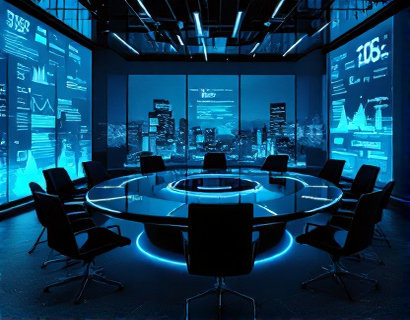Custom Business Card Creation for E-commerce Brands: A Guide to Professional Branding and Online Success
In the digital age, where online presence is crucial for business success, the importance of professional branding extends beyond the virtual realm to physical touchpoints. One such tangible element that can significantly enhance a brand's image and networking effectiveness is the custom business card. For e-commerce brands, freelancers, entrepreneurs, and corporate leaders, a well-designed business card serves as a microcosm of their brand identity, making a lasting impression in face-to-face interactions. This guide delves into the art and science of creating custom business cards that not only reflect your brand's unique identity but also contribute to your overall online and offline success.
Understanding the Role of Business Cards in Branding
The business card is more than just a piece of paper with contact information. It is an extension of your brand, a physical representation of your professional image. For e-commerce brands, which often lack a physical storefront, business cards become even more critical as they provide a tangible connection to the brand. A well-designed card can spark curiosity, build trust, and leave a memorable impression, all of which are vital for converting initial encounters into long-term business relationships.
Moreover, in a sea of digital interactions, a unique and high-quality business card can differentiate you from competitors. It serves as a conversation starter, encouraging recipients to learn more about your brand. This is particularly important for e-commerce businesses where personal connections can lead to repeat purchases and customer loyalty.
Key Elements of a Professional Business Card
To create a business card that effectively represents your brand, several key elements must be considered. These elements work together to ensure that your card is not only visually appealing but also functional and memorable.
1. Brand Colors and Logo
The use of your brand's primary colors and logo is essential. These visual elements instantly communicate who you are and help reinforce brand recognition. Consistency in color schemes and logo placement across all branding materials, including business cards, is crucial for building a strong and cohesive brand identity.
2. Typography
Font choice and size play a significant role in the readability and aesthetic of your business card. Select fonts that align with your brand's personality—whether it's modern and sleek, classic and elegant, or playful and creative. Ensure that the text is legible, with a clear hierarchy that prioritizes the most important information.
3. Contact Information
While it may seem basic, the inclusion of accurate and complete contact information is non-negotiable. This includes your name, job title, phone number, email address, and website URL. For e-commerce brands, adding social media handles can also be beneficial, providing multiple ways for potential customers to connect.
4. Unique Features
To stand out, consider incorporating unique features that add value and memorability. This could be a special finish, such as matte, glossy, or textured paper, or innovative shapes and sizes. For instance, a rounded corner or a die-cut design can make your card more noticeable and engaging.
5. Messaging and Tagline
A well-crafted tagline or a brief message can encapsulate your brand's value proposition. This should be concise yet impactful, providing a quick snapshot of what your brand offers. Ensure that the messaging aligns with your overall brand strategy and resonates with your target audience.
Choosing the Right Design for Your Business Card
With the numerous design options available, selecting the right one for your business card requires careful consideration. Here are some steps to guide you through the process:
1. Define Your Brand Identity
Before diving into design, clearly define your brand's identity. Consider your brand's personality, values, and target audience. This will help you make informed decisions about colors, fonts, and messaging.
2. Research and Inspiration
Explore design inspiration from various sources, including design blogs, social media, and business card galleries. Pay attention to what resonates with you and what doesn't. Collect ideas that align with your brand's aesthetic and values.
3. Customizable Templates
Utilize customizable templates from reputable design platforms. These templates offer a solid foundation while allowing you to personalize key elements. Look for platforms that provide a wide range of templates tailored to different industries and brand styles. This approach saves time and ensures a professional look without requiring extensive design expertise.
4. Professional Design Services
If you prefer a more personalized and high-end approach, consider working with a professional designer. This option is particularly beneficial for brands with unique requirements or those looking for a bespoke design. Professional designers can bring creativity and expertise to the table, ensuring your business card stands out.
The Design Process
Once you have selected a template or hired a designer, the design process can begin. Here’s a step-by-step guide to help you navigate this phase:
1. Initial Consultation
If working with a designer, start with an initial consultation to discuss your vision, goals, and budget. This is an opportunity to provide detailed feedback and ensure the designer understands your brand's essence.
2. Design Concepts
The designer will present several design concepts based on your inputs. Review these carefully, providing feedback and requesting adjustments as needed. This iterative process ensures that the final design aligns perfectly with your expectations.
3. Final Approval
Once you are satisfied with the design, give your final approval. Pay close attention to details such as color accuracy, font sizes, and layout. A clear and concise approval process prevents misunderstandings and ensures a smooth production flow.
Production and Delivery
After the design is finalized, the next step is production. Here are some factors to consider to ensure a seamless experience:
1. Material Selection
Choose high-quality paper stock that reflects your brand's premium image. Options range from standard glossy and matte finishes to more unique textures like linen or cotton. The material not only affects the card's feel but also its durability and appearance.
2. Printing Methods
Different printing methods offer varying levels of quality and cost. Offset printing is ideal for large orders and provides sharp, high-quality prints. For smaller runs or unique designs, digital printing is a cost-effective and flexible option. Consider the trade-offs between cost, quantity, and quality when making your choice.
3. Ordering Process
Utilize a reliable and user-friendly platform to place your order. Look for platforms that offer a straightforward ordering process, clear pricing, and transparent shipping options. Ensure that the platform provides options for customization and allows you to preview the final product before printing.
4. Shipping and Delivery
Consider the shipping speed and reliability, especially if you need the cards urgently. Some platforms offer expedited shipping, which can be crucial for timely delivery. Additionally, verify the packaging options to ensure the cards arrive in excellent condition.
Maximizing the Impact of Your Business Card
Once your business cards are in hand, their impact depends on how you use them. Here are some strategies to maximize their effectiveness:
1. Strategic Distribution
Distribute your business cards strategically at relevant events, networking meetings, and industry conferences. Tailor your approach to the context, ensuring that you are handing out cards to people who can benefit from knowing you and your brand.
2. Follow-Up
After receiving a business card, follow up with a personalized message or email. This not only reinforces the connection but also shows that you value the interaction. Include a unique note or question to make the follow-up more personal.
3. Digital Integration
In the digital age, integrating your business card with digital platforms can enhance its utility. Consider creating a QR code that links to your website, portfolio, or a specific landing page. This adds a modern touch and provides recipients with immediate access to more information about your brand.
4. Feedback and Iteration
Solicit feedback from colleagues, clients, and peers on your business cards. Use this input to make improvements in future designs. Continuous iteration ensures that your business cards remain relevant and effective.
Conclusion
In conclusion, a well-designed business card is a powerful tool for e-commerce brands, freelancers, and corporate leaders looking to enhance their professional image and drive online success. By understanding the role of business cards, selecting the right design elements, choosing a reliable production method, and strategically distributing and following up, you can create a lasting impression that translates into real-world results. Investing time and effort into your business cards is an investment in your brand's success.











































